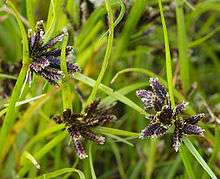Cyperus fuscus
Cyperus fuscus is a species of sedge known by the common name brown galingale,[1] or brown flatsedge. This plant is native to much of Europe, Asia and North Africa from England, Portugal and Morocco east to China and Thailand. It is an introduced species in North America, where it is naturalized in widely scattered locations in the United States and Canada.[2][3][4][5][6]
| Brown flatsedge | |
|---|---|
 | |
| Scientific classification | |
| Kingdom: | Plantae |
| Clade: | Tracheophytes |
| Clade: | Angiosperms |
| Clade: | Monocots |
| Clade: | Commelinids |
| Order: | Poales |
| Family: | Cyperaceae |
| Genus: | Cyperus |
| Species: | C. fuscus |
| Binomial name | |
| Cyperus fuscus | |
Cyperus fuscusis a plant of wet areas, particularly disturbed places such as ditches and temporary ponds. It is an annual herb with paper-thin stems reaching 30 centimeters in maximum height. There may be short, flat leaves about the base of the plant. The inflorescence contains three to 15 spikelets, which are flat, oval or rectangular, and dark brown to deep purple. Each spikelet has around ten flowers enclosed in dark bracts. The fruit is a light brown achene about a millimeter long. In the UK, Cyperus fuscus is one of 101 species named as a priority for conservation by the conservation charity Plantlife.[7]
References
- "BSBI List 2007". Botanical Society of Britain and Ireland. Archived from the original (xls) on 2015-01-25. Retrieved 2014-10-17.
- Kew World Checklist of Selected Plant Families
- Altervista Flora Italiana, Zigolo nero, Brown Flatsedge, Cyperus fuscus L.
- Flora of China Vol. 23 Page 226 褐穗莎草 he sui suo cao Cyperus fuscus Linnaeus, Sp. Pl. 1: 46. 1753.
- Flora of North America, Vol. 23 Page 157, Cyperus fuscus Linnaeus, Sp. Pl. 1: 46. 1753.
- Biota of North America Program, 2013 county distribution map
- "Archived copy". Archived from the original on 2010-01-27. Retrieved 2009-11-05.CS1 maint: archived copy as title (link) Plantlife website
External links
- Jepson Manual Treatment
- USDA Plants Profile
- Photo gallery
- Cyperus fuscus Species listing page.